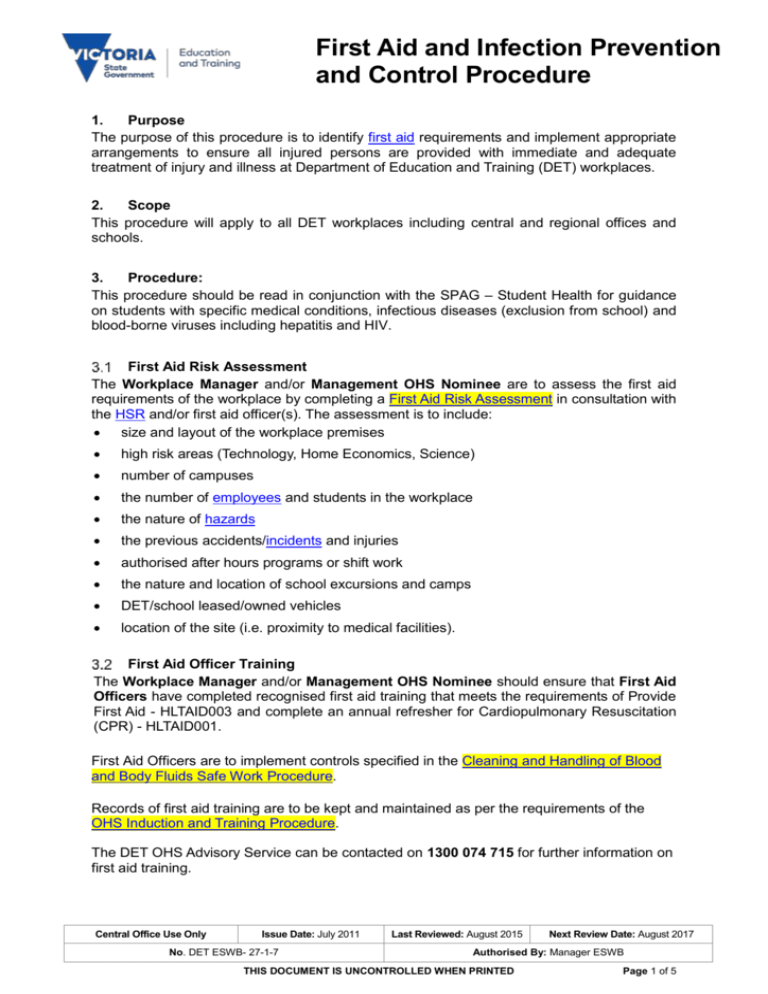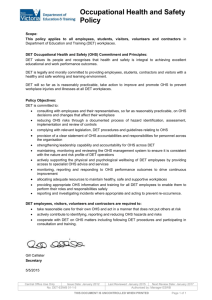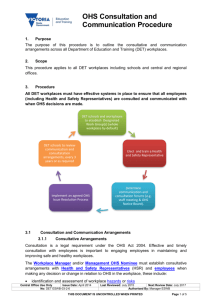First Aid & Infection Control Procedure
advertisement

First Aid and Infection Prevention and Control Procedure 1. Purpose The purpose of this procedure is to identify first aid requirements and implement appropriate arrangements to ensure all injured persons are provided with immediate and adequate treatment of injury and illness at Department of Education and Training (DET) workplaces. 2. Scope This procedure will apply to all DET workplaces including central and regional offices and schools. 3. Procedure: This procedure should be read in conjunction with the SPAG – Student Health for guidance on students with specific medical conditions, infectious diseases (exclusion from school) and blood-borne viruses including hepatitis and HIV. First Aid Risk Assessment The Workplace Manager and/or Management OHS Nominee are to assess the first aid requirements of the workplace by completing a First Aid Risk Assessment in consultation with the HSR and/or first aid officer(s). The assessment is to include: size and layout of the workplace premises high risk areas (Technology, Home Economics, Science) number of campuses the number of employees and students in the workplace the nature of hazards the previous accidents/incidents and injuries authorised after hours programs or shift work the nature and location of school excursions and camps DET/school leased/owned vehicles location of the site (i.e. proximity to medical facilities). First Aid Officer Training The Workplace Manager and/or Management OHS Nominee should ensure that First Aid Officers have completed recognised first aid training that meets the requirements of Provide First Aid - HLTAID003 and complete an annual refresher for Cardiopulmonary Resuscitation (CPR) - HLTAID001. First Aid Officers are to implement controls specified in the Cleaning and Handling of Blood and Body Fluids Safe Work Procedure. Records of first aid training are to be kept and maintained as per the requirements of the OHS Induction and Training Procedure. The DET OHS Advisory Service can be contacted on 1300 074 715 for further information on first aid training. Central Office Use Only Issue Date: July 2011 No. DET ESWB- 27-1-7 Last Reviewed: August 2015 Next Review Date: August 2017 Authorised By: Manager ESWB THIS DOCUMENT IS UNCONTROLLED WHEN PRINTED Page 1 of 5 First Aid and Infection Prevention and Control Procedure First Aid Rooms/Sick Bays Where schools and other DET workplaces have a first aid room, it should be located so as to be accessible to injured persons. It should be well-lit, ventilated and clearly identified with appropriate signage. Workplaces without a first aid room should provide a first aid area (sick bay) for ill or injured people to rest in. Sickbays should meet as many as possible of the minimum requirements for first aid rooms. The First Aid Summary Sheet or Emergency Management Contact Details Sheet must be completed and should include the details of the current First Aid Officer(s) and be displayed in the First Aid room/Sickbay (in close proximity to First Aid Kits) and on the OHS Notice Board. 3.3.1 Minimum First Aid Room Requirements The following items are minimum requirements when establishing a first aid room: Personal Protective Equipment (eye protection, gloves, apron/gown) First aid kit appropriate for the workplace Resuscitation mask Blankets and pillows Electric power points An upright chair Sharps disposal system Desk and telephone Biohazard Waste Container/ Sanitary Waste Bin List of emergency telephone numbers Work bench or dressing trolley Storage cupboards First Aid Summary Sheet or Emergency Management Contact Details Sheet clearly displayed Sink (with hot and cold water) Stretcher (If a need is identified using First Aid Risk Assessment) 3.3.2 First Aid Kits The Workplace Manager and/or Management OHS Nominee are required to determine the appropriate contents of the workplace first aid kits in consultation with Health and Safety Representatives and employees. First aid kits should meet the first aid requirements of individual schools and other DET workplaces. This includes the number of first aid kits and their contents as identified in the First Aid Risk Assessment. Regular inspections of first aid facilities, including a review of the first aid kits on site, are to be scheduled into the OHS Activities Calendar or equivalent template and conducted using the First Aid Kit Contents Checklist and or equivalent template. The First Aid Officer should also ensure that first aid kit contents are restocked within date, as required. 3.3.3 Automatic External Defibrillators Automatic External Defibrillators (AED) are not normally required in first aid kits or first aid room supplies. Schools and other DET workplaces may determine that an AED be included as part of the first aid provision, particularly where the First Aid Risk Assessment indicates circumstances where life-threatening injuries could result and timely access to emergency services cannot be assured. Prospective AED operators should be trained in their correct use. As a guide, refresher training is required every twelve months. AED function, batteries and pads should be checked monthly and after each use. Central Office Use Only Issue Date: July 2011 No. DET ESWB- 27-1-7 Last Reviewed: August 2015 Next Review Date: August 2017 Authorised By: Manager ESWB THIS DOCUMENT IS UNCONTROLLED WHEN PRINTED Page 2 of 5 First Aid and Infection Prevention and Control Procedure Dispensing Medication The Workplace Manager should ensure that a Medication Authority Form for all medication to be administered by the school has been obtained and checked to ensure it has been completed by a medical practitioner or by a parent/guardian, as agreed by the parent(s) and Workplace Manager. Employees may administer medication to students as required and as directed by the Workplace Manager. Analgesics, such as, aspirin and paracetamol are not to be stored or dispensed to students. Employees are responsible for carrying and dispensing their own medication (prescribed or over the counter). Where medication is required in spontaneous situations, detailed administration instructions should be provided (e.g. asthma attacks). For further information, refer to SPAG – Student Health. A medication log or equivalent official medications register should be used by the person administering the medication. Infection and Prevention Control Adequate infection and prevention control must be practiced at all times when administering first aid or cleaning up blood or body fluids. The following infection control procedures must always be adhered to: cover cuts and abrasions with water proof occlusive dressing to avoid contamination of cuts/abrasions with another person’s blood and/or body fluids wear protective gloves when in contact with body fluids, non-intact skin and mucous membranes wear a mask, eye protection and a gown where there is a risk of splashing blood or other body fluids remove any broken glass or sharp material with forceps or tongs and place in sharps container wash hands thoroughly after direct contact with injured person or blood/body fluids with warm soapy water, rinse, dry and sanitise hands using an alcohol-based rub or gel. Cleaning and Sanitising Where a blood/biological spill has occurred the following must be adhered to: isolate the area where the incident occurred clean up blood and other body fluids spills with disposable paper towels/tissues or by using a Biohazard Spill Kit use hospital grade disinfectant (use 5ml of bleach to 500ml of water) to sanitise the area dry the area with disposable paper towels/tissues after clean-up (as wet areas attract contaminants) where a spill occurs on carpet, shampoo as soon as possible. Do not use disinfectant. Steam cleaning may be used instead Items such as scissors and tweezers are to be cleaned and disinfected/sterilized after use. Disposal of Contaminated Waste Contaminated waste (e.g. dressings, wipes, cleaning cloths, nappies, human tissue, and blood and laboratory waste) should be disposed of in: appropriate biohazard waste containers/bags; or in the general waste in suitably labelled bags (bags are to be double bagged); or Central Office Use Only Issue Date: July 2011 No. DET ESWB- 27-1-7 Last Reviewed: August 2015 Next Review Date: August 2017 Authorised By: Manager ESWB THIS DOCUMENT IS UNCONTROLLED WHEN PRINTED Page 3 of 5 First Aid and Infection Prevention and Control Procedure Sanitary Waste Bins. Sharps should be disposed of in a sharps container. All sharps containers must be compliant with AS 4031: Non reusable containers for the collection of sharps medical items used in health care areas. Recording the Administration of First Aid Treatment and Incidents When first aid treatment has been administered to an employee the incident is to be reported onto eduSafe. When first aid has been administered to a student the incident is to be reported onto CASES21. All incidents reported as a result of suspected/actual infection should be investigated using the Hazard/Incident Investigation Template. When relevant, counselling is should be offered to affected employees through DET’s Employee Assistance Program by calling 1300 361 008. Medical Information and Confidentiality DET schools and workplaces should ensure privacy of information is maintained as per the SPAG – Information Privacy. Hepatitis Further controls specifically related to hepatitis can be found in Guidelines for Hepatitis. Asthma Controls specifically related asthma can be found in the SPAG - Asthma. Allergic Reactions Controls specifically related allergic reactions can be found in the SPAG - Student Health and Wellbeing- Anaphylaxis. 4. Defined Terms All terms defined by the DET are hyperlinked to the DET Defined Health, Safety Terms Website. Defined roles will appear in bold. 5. Related Legislation Occupational Health and Safety Act 2004 Occupational Health and Safety Regulations 2007 AS 4031: Non-reusable containers for the collection of sharp medical items used in health care areas Victorian WorkCover Authority Compliance Code – First Aid in the Workplace The Blue Book- Guidelines for the Control of Infectious Diseases, Department of Health Victoria 6. Checklist Tasks/Actions Completed First Aid Risk Assessment has been conducted A First Aid Summary Sheet has been displayed in the First Aid Room, near First Aid Kits and on the OHS Notice Board Central Office Use Only Issue Date: July 2011 No. DET ESWB- 27-1-7 Last Reviewed: August 2015 Next Review Date: August 2017 Authorised By: Manager ESWB THIS DOCUMENT IS UNCONTROLLED WHEN PRINTED Page 4 of 5 First Aid and Infection Prevention and Control Procedure Minimum First Aid Room requirements have been met, see section 6.3.1 First Aid Kits have been stocked and inspected and are within date 7. Version Control Version Section Amended Amendment Date Created Author 2 All Two yearly review as per OHSMS requirements. April 2011 Employee Health Unit 3 All Replaced reference to VGSRG with School Policy and Advisory Guide. Updated wording in regards to reusable first aid items. July 2011 Employee Health Unit 4 New section 6.1.1 Inclusion of section in regards to defibrillators April 2013 ESWB And 6.2 Inclusion of a suitably labelled bag for contaminated waste. Removal of reference Regional Advisors. to OHS Change of heading to reflect requirements in AS/NZS: 4801: 2001 Two yearly review as per OHSMS requirements 5 All Clarification of biological waste disposal processes and inclusion of an annual CPR refresher program. September 2013 ESWB 6 All Clarification of administering first aid treatment, dispensing of medication, disposal of biological waste. Addition of cleaning and sanitising. June 2014 ESWB August 2015 ESWB Change to First Aid training course codes to align with revised training code. Addition of reference to Cleaning and Handling of Blood SWP Minor wording changes to section 6.2. 7 All Change to new procedure format. Change in logo. Central Office Use Only Issue Date: July 2011 No. DET ESWB- 27-1-7 Last Reviewed: August 2015 Next Review Date: August 2017 Authorised By: Manager ESWB THIS DOCUMENT IS UNCONTROLLED WHEN PRINTED Page 5 of 5







